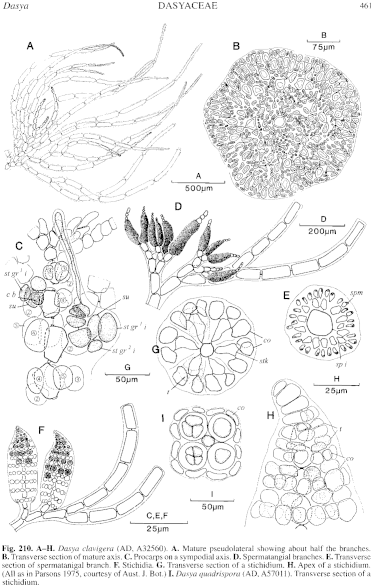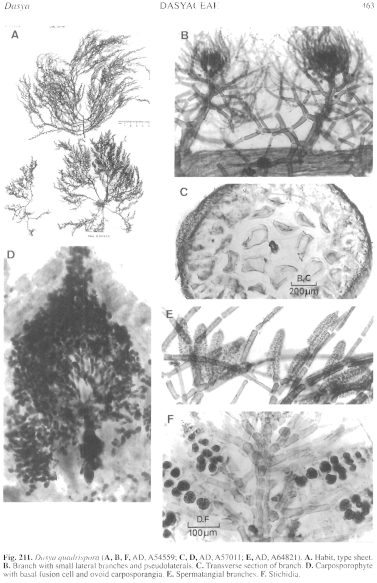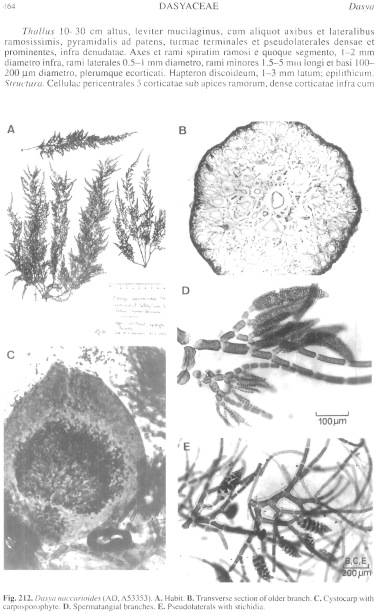|
|
|
|
|
|||||||||||
|
Electronic Flora of South Australia Species Fact Sheet
Phylum Rhodophyta – Order Ceramiales – Family Dasyaceae
Thallus (Fig. 211A) medium to dark red-brown, 10–30 cm high, slightly mucilaginous, with several much branched axes and laterals, pyramidal to spreading in outline, terminal pseudolateral tufts dense and fairly prominent, denuded below. Axes and branches spirally branched from each segment, 1–2 mm in diameter below; lateral branches 0.5–1 mm in diameter, lesser branches 1.5–5 mm long and basally 100–200 µm in diameter, mostly ecorticate. Holdfast discoid, 1–3 mm across; epilithic. Structure. Pericentral cells 5, becoming corticate from several segments below branch apices, first by filaments of elongate cells lying between the pericentral cells, densely corticated below with the pericentral cells without surrounding rhizoids and remaining clear in section (Fig. 211C). Lateral branches arising from the basal cells of pseudolaterals. Pseudolaterals (Fig. 211B) one per segment, spirally arranged, 0.5–1 mm long with 3–5 subdichotomies usually every 1 (–2) cell below, upper filaments slender and unbranched; subdichotomies with joint walls basally adherent; basal and next cells 35–90 (–130) µm in diameter and L/D (1–) 1.5–2.5, usually tapering evenly and markedly to slender upper cells (often lost) 4–6 µm in diameter and L/D 8–15, ends rounded. Adventitious filaments absent; adventitious branches occasional. Rhodoplasts discoid to elongate, becoming ribbon like or in chains.
Reproduction: Gametophytes dioecious. Procarps not observed. Carposporophytes (Fig. 211D) with a prominent fusion cell and basal nutritive cells, gonimoblast much branched with terminal rows of ovoid carposporangia 15–25 µm in diameter. Cystocarps urceolate with a globose base 0.5–1.2 mm across and a neck 100–250 µm long, sessile on lesser branches; pericarp 3–4 cells thick, outer cells ovoid, irregular. Spermatangial branches (Fig. 211E) on mid cells of pseudolaterals, lanceoid to cylindrical, 120–250 µm long and 35–65 µm in diameter with 8–12 fertile segments, with a single pedicel and 1–2 apical cells.
Tetrasporangial stichidia (Fig. 211F) on lower cells of pseudolaterals, cylindrical and tapering above, on a 1–2-celled pedicel, 200–600 µm long and 80–140 µm in diameter, with 5–8 fertile segments each with 4 pericentral cells (Fig. 2101) and subspherical tetrasporangia 30–50 µm in diameter, tetrahedrally divided, each with 3 ovoid cover cells.
Type from Bridport, N Tasmania (Womersley & Parsons, 6.xi.1982); type sheet (female, male and tetrasporangial) in AD, A54559 (holotype tetrasporangial), isotype sheet in CHR, 392851.
Selected specimens: Hopetoun, W. Aust., drift (Parsons, 20.xi.1968; AD, A33357). Pearson I., S. Aust., 5–12 m deep (Shepherd, 8.i.1969; AD, A34101). Elliston, S. Aust., 5 m deep in bay (Shepherd, 24.x.1973; AD, A44277). N Spencer Gulf, S. Aust., 9 m deep (Shepherd, 13.ix.1973; AD, A44188). Port Turton, S. Aust., 3–5 m deep (Kraft, 17.ix.1973; AD, A44020). Edithburg, S. Aust., 1–4 m deep in pool (Prud'homme van Reine, 14.x.1988; AD, A59226). Rapid Head, S. Aust., 4 m deep (Cambridge, 8.0.1985; AD, A56372). American R. inlet, Kangaroo I., S. Aust., drift (Womersley, 25.viii.1963; AD, A26748). Muston, American R. inlet, Kangaroo I., S. Aust., upper sublittoral (Womersley, 27.viii.1950; AD, A15355) and 2–3 m deep (Womersley, 21.xi.1968; AD, A32593). Saunders Beach, Kangaroo I., S. Aust., drift (Womersley, 25.viii.1963; AD, A26721). Ironstone Point (E of Penneshaw), Kangaroo I., S. Aust., 7 m deep (Lavers, 4.iv.1996; AD, A64821). Port MacDonnell, S. Aust., drift (Womersley, 16.x.1985; AD, A57011). Bay of Islands, W of Port Campbell, Vic., drift (Mitchell, 28.viii.1965; AD, A29513). Stanley, N Tas., drift (Womersley, 17.x.1982; AD, A56231).
Distribution: Hopetoun, W. Aust., to N Tasmania.
Taxonomic notes: D. quadrispora is named from the whorls of 4 tetrasporangia in the stichidia; it is probably closely related to the West Australian D. elongata Sonder (1845, p. 53), with which D. frutescens Harvey (1853a, p. 542) is closely related . They are similar in lack of rhizoids in the axes and stichidia with 4 (or 5) tetrasporangia, but D. elongata differs in having pseudolaterals which taper evenly to relatively short upper and subterminal cells (20–30 µm in diameter and L/D 1–2).
AD, A44188, from a sheltered water habitat, has pseudolaterals with slenderer lower cells than plants from greater water movement, but otherwise agrees with D. quadrispora.
References:
SONDER, O.G. (1845). Nova Algarum genera et species, quas in itinere ad oras occidentales Novae Hollandiae, collegit L. Preiss, Ph.Dr. Bot. Zeit. 3, 49–57.
The Marine Benthic Flora of Southern Australia Part IIIC complete list of references.
Publication:
Womersley, H.B.S. (24 December, 1998)
The Marine Benthic Flora of Southern Australia
Rhodophyta. Part IIIC. Ceramiales – Ceramiaceae, Dasyaceae
©State Herbarium of South Australia, Government of South Australia
Illustrations in Womersley Part IIIA, 1998: FIGS 210 I, 211, 212.

Figure 210 enlarge
Fig. 210. A–H. Dasya clavigera (AD, A32560). A. Mature pseudolateral showing about half the branches. B. Transverse section of mature axis. C. Procarps on a sympodial axis. D. Spermatangial branches. E. Transverse section of spermatanigal branch. F. Stichidia. G. Transverse section of a stichidium. H. Apex of a stichidium. (All as in Parsons 1975, courtesy of Aust. J. Bot.) I. Dasya quadrispora (AD, A57011). Transverse section of a stichidium.

Figure 211 enlarge
Fig. 211. Dasya quadrispora (A, B, F, AD, A54559; C, D, AD, A57011; E, AD, A64821). A. Habit, type sheet. B. Branch with small lateral branches and pseudolaterals. C. Transverse section of branch. D. Carposporophyte with basal fusion cell and ovoid carposporangia. E. Spermatangial branches. F. Stichidia.

Figure 212 enlarge
Fig. 212. Dasya naccarioides (AD, A53353). A. Habit. B. Transverse section of older branch. C. Cystocarp with carposporophyte. D. Spermatangial branches. E. Pseudolaterals with stichidia.

|
Email Contact: State Herbarium of South Australia |

|